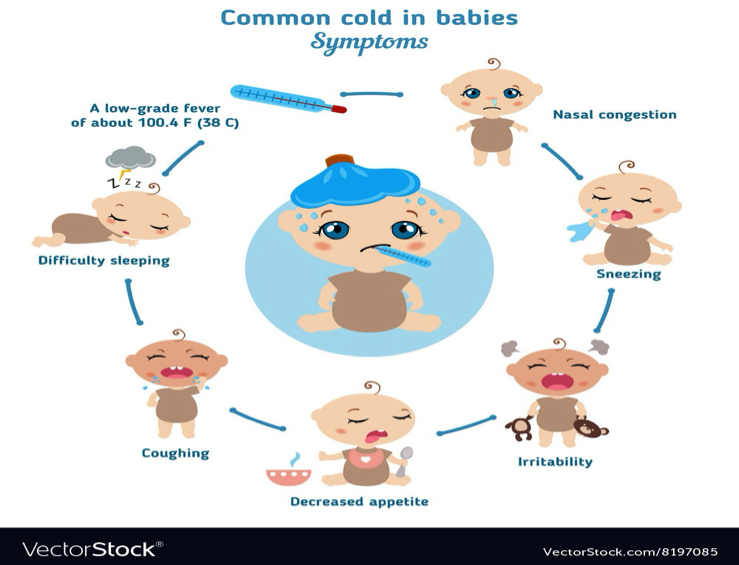THE COMMON COLD (CORYZA)
Etiology
There are more than 100 different varieties of rhinovirus, the type of virus responsible for the greatest number of colds.
Other viruses that cause colds include enteroviruses (echovirus and coxsackieviruses) and coronaviruses.
Seasonal Patterns
Any time of year, although most colds occur during the early fall until the late spring.
Transmission
-
Direct hand contact.
-
Inhalation of small-particle aerosols that are airborne from coughing.
-
Deposition of large-particle aerosols that are expelled during a sneeze and land on nasal or conjunctival mucosa.
-
Colds are most contagious during the first two to four days.
-
Young children have an average of 6-8 colds per year, but 10–15% of children have at least 12 infections per year.
-
The incidence of illness decreases with increasing age, with 2-3 illnesses per year by adulthood.
-
Children in out-of-home daycare centers during the 1st year of life have 50% more colds than children cared for only at home.
-
The difference in the incidence of illness between these groups of children decreases as the length of time spent in daycare increases, although the incidence of illness remains higher in the daycare group through at least the 1st 3 years of life.
CLINICAL PICTURE
In Young Infants (more severe disease)
- Fever, irritability, sneezing.
- Nasal obstruction (snoring) + discharge.
- Difficult feeding.
- Congested ear drums.
- +/- vomiting, diarrhea.
The onset of common cold symptoms typically occurs 1-3 days after viral infection.
The first symptom noted is often sore or scratchy throat, followed closely by nasal obstruction and rhinorrhea.
Cough is associated with two-thirds of colds in children and usually begins after the onset of nasal symptoms. Cough may persist for an additional 1-2 wk after resolution of other symptoms.
The usual cold persists for approximately 1 wk, although 10% last for 2 wk.

In Older Children (milder disease)
- No fever, or low-grade fever, sneezing.
- Body aches and headache.
- Nasal obstruction, no respiratory distress.
- Nasal discharge: thin → thick → purulent +/- cough.
- Mouth breathing → dry mouth and soreness.

The onset of common cold symptoms typically occurs 1-3 days after viral infection.
The first symptom noted is often sore or scratchy throat, followed closely by nasal obstruction and rhinorrhea.
Cough is associated with two-thirds of colds in children and usually begins after the onset of nasal symptoms. Cough may persist for an additional 1-2 wk after resolution of other symptoms.
The usual cold persists for approximately 1 wk, although 10% last for 2 wk.
TREATMENT
NO SPECIFIC TREATMENT Antibiotics DO NOT AFFECT THE COURSE and DO NOT REDUCE INCIDENCE OF BACTERIAL COMPLICATIONS.
- Maintain good nutrition and fluid intake.
- Paracetamol or ibuprofen but avoid aspirin.
ASPIRIN + INFLUENZA INFECTION → ↑ THE RISK OF REYE SYNDROME
Relieve nasal obstruction:
-
Sterile saline, or phenylephrine (0.125-0.25% risk of chemical rhinitis after 5 days use) nasal drops administered 15 minutes before feeding and at bedtime for not more than 5 days.
-
Suction with a soft rubber bulb can help in clearing nasal obstruction in young infants.
Herbal and alternative treatments:
- Honey (5-10 mL in children ≥1 yr old) has a modest effect on relieving nocturnal cough.
- Zinc.
- There is some evidence that prophylactic use of vitamin C may decrease the duration of the common cold in children and adults.
Maintaining adequate oral hydration may help to prevent dehydration and to thin secretions and soothe respiratory mucosa.
The common home remedy of ingesting warm fluids may soothe mucosa, increase nasal mucous flow, or loosen respiratory secretions.